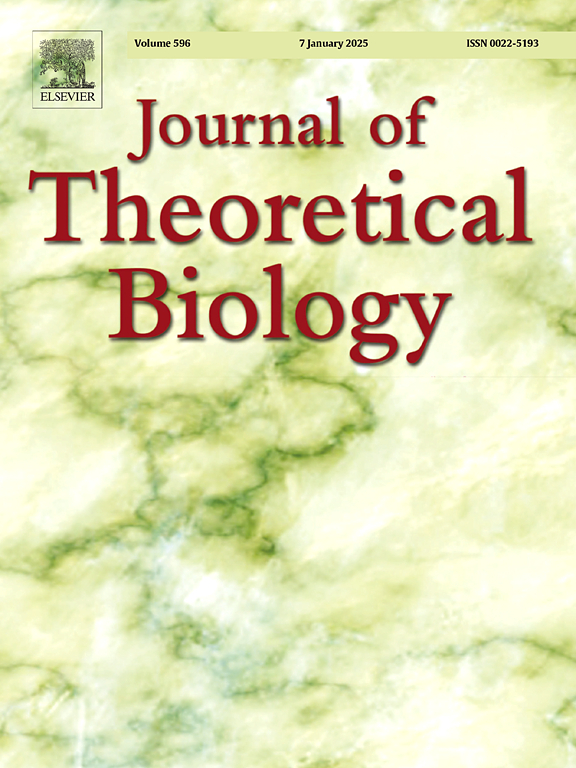生长细胞中核细胞质运输和核细胞比的数学模型。
IF 2
4区 数学
Q2 BIOLOGY
引用次数: 0
摘要
在细胞生长过程中,细胞核和细胞质的生长是相互协调的,在整个细胞周期中,细胞核与细胞的体积比(N/C)几乎是恒定的。先前的研究表明,N/C比率是由细胞核中蛋白质数量与细胞中蛋白质总数之比决定的。这些观察结果表明,通过调节细胞核和细胞质中的蛋白质浓度,核胞质转运过程在细胞核大小中的重要性。本文结合了ran介导的核细胞质运输的生物物理模型和简单的细胞生长模型,以提供对生长细胞中N/C比稳态的几个关键方面的见解。我们的模型表明,核膜的通透性需要与细胞一致生长才能维持一个近乎恒定的N/C比,核胞质转运机制和基因翻译中涉及的几个参数显著影响N/C比,Ran可能潜在地弥补核胞质转运机制中NTF2的缺失,以维持一个可行的N/C比。然而,这种补偿只有在允许RanGDP独立于NTF2通过核包膜转运的情况下才有可能实现。本文章由计算机程序翻译,如有差异,请以英文原文为准。
Mathematical model of nucleocytoplasmic transport and nuclear-to-cell ratio in a growing cell
It has been observed that the growth of the nucleus and the cytoplasm is coordinated during cell growth, resulting in a nearly constant nuclear-to-cell volume ratio (N/C) throughout the cell cycle. Previous studies have shown that the N/C ratio is determined by the ratio between the number of proteins in the nucleus and the total number of proteins in the cell. These observations suggest the importance of the nucleocytoplasmic transport process in nuclear size by regulating protein concentrations in the nucleus and cytoplasm. This paper combines a biophysical model of Ran-mediated nucleocytoplasmic transport and a simple cell growth model to provide insights into several key aspects of the N/C ratio homeostasis in growing cells. Our model shows that the permeability of the nuclear envelope needs to grow in line with the cell to maintain a nearly constant N/C ratio, that several parameters involved in the nucleocytoplasmic transport mechanism and gene translation significantly affect the N/C ratio, and that Ran may potentially compensate for the lack of NTF2 in the nucleocytoplasmic transport mechanism to maintain a viable N/C ratio. However, this compensation is possible only if RanGDP is allowed to translocate through the nuclear envelope independently of NTF2.
求助全文
通过发布文献求助,成功后即可免费获取论文全文。
去求助
来源期刊
CiteScore
4.20
自引率
5.00%
发文量
218
审稿时长
51 days
期刊介绍:
The Journal of Theoretical Biology is the leading forum for theoretical perspectives that give insight into biological processes. It covers a very wide range of topics and is of interest to biologists in many areas of research, including:
• Brain and Neuroscience
• Cancer Growth and Treatment
• Cell Biology
• Developmental Biology
• Ecology
• Evolution
• Immunology,
• Infectious and non-infectious Diseases,
• Mathematical, Computational, Biophysical and Statistical Modeling
• Microbiology, Molecular Biology, and Biochemistry
• Networks and Complex Systems
• Physiology
• Pharmacodynamics
• Animal Behavior and Game Theory
Acceptable papers are those that bear significant importance on the biology per se being presented, and not on the mathematical analysis. Papers that include some data or experimental material bearing on theory will be considered, including those that contain comparative study, statistical data analysis, mathematical proof, computer simulations, experiments, field observations, or even philosophical arguments, which are all methods to support or reject theoretical ideas. However, there should be a concerted effort to make papers intelligible to biologists in the chosen field.

 求助内容:
求助内容: 应助结果提醒方式:
应助结果提醒方式:


